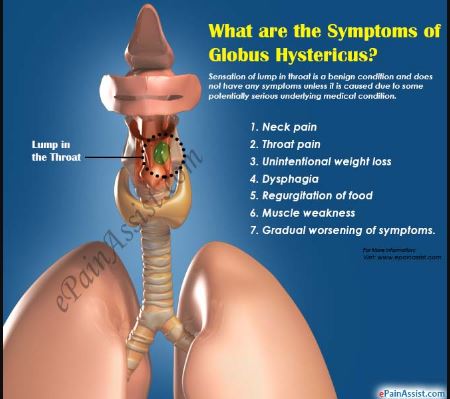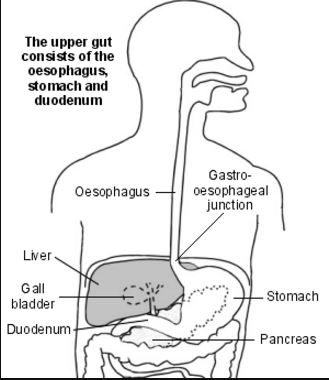Globus Hystericus
What Is Globus Hystericus?
The Globus Hystericus is a medical condition that is an intermittent non-painful sensation in the throat. It is commonly long-lasting condition, hard to treat and always has a tendency to recur.
Globus sensation is the usual term used when a particular person has the feeling of a lump in their throat even though there is none. In this article we will explore the things you should know about the sensation lump in your throat.
The Globus Hystericus is sometimes called Globus Pharynges (refers to the throat), but the most usual term for this medical ailment is Globus sensation.
A feeling of lump in the throat even if there is none during the medical examination. The sensation is persistent and it usually may come and go. However, it does not interfere with your eating or drinking, as a matter of fact the food and water intake can rid of the symptoms.


Prevalance
In many cases, the prevalence rate of Globus Hystericus was found out to be the seventh most common complaint or 4.1% among 4,330 consecutive first-five patients visit to a general otolaryngology clinic-Pubmed.com says.
This lump sensation in the throat is relatively common among men but also affect certain percentage of women. Furthermore, the condition is reported also of 46% healthy individuals is being infested at their middle age, though the latter ages are more likely to seek health care professional if the symptoms persist.
What causes it?
The cause of the Globus Hystiricus is really uncertain, but some experts determined it through medical and intensive investigation. According to Susan Butler, PhD associate professor of surgical sciences-otolaryngology at Wake Forest Baptist Medical Center, the condition is highly caused by stomach reflux in the upper esophagus, wherein it causes the esophageal sphincter (UES) muscle to go into spasm which resulted to the sensation of something stuck in the throat.
“When they try to swallow, the cricopharyngeus/UES will not relax to let a big bolus or a big piece of food go into the esophagus. They can have solid food right above their airway. And some of those patients have had situations where they’ve needed the Heimlich maneuver to cough out a pill or piece of meat out of their airway,” Butler said.
On the other hand, other causes may trigger the development of the sensational lump in the throat such as stress due to exhaustion that it can even make the symptoms worse.
For instance, the Globus sensation can trigger to cause excessive mucus running from the nose down in the dorsal of the throat, commonly known as postnasal drip, resulting to worsening of the Globus Hystericus symptoms.
Other causes may include;
- Voice damaging (over usage of the vocal cords)
- Smoking and bad habit lifestyle
- Lack of rest (promote stress, ergo causing an increase in muscle tension
Symptoms
As Globus Hystericus name as sensational lump in the throat, the common symptom is the sensation of “something” stuck in the throat that may come and go over the period of time. The unusual feeling can be sense in front of the neck and can move around up and down. In many cases of Globus Hystericus several symptoms can be characterized and suggests another disorder present in concern such as;
- Dysphagia (Difficulty in swallowing and sometimes choked when eating)
- Feeling of a movable mass in the throat
- Hemoptysis (expectoration of blood or of blood stained sputum from the bronchi, larynx, trachea or lungs.)
- Hoarseness of voice
- Muscle weaknesses
- Over weight loss
- Persistent of all the symptoms
- Regurgitation or spewing of food
- Sore Throat
- Throat pain or Throat irritation


Will this be a sign of health risk?
Some individual conceptualize the lump sensation or Globus Hystericus as cancer related, a common misconception about the condition. Therefore, in order to make sure the underlying disease must prevented, people who have warning symptoms should see a doctor within a few days or few weeks.
Moreover, for those who don’t still should set an appointment to their health professional to thoroughly identify the underlying cause of sensation depending on the severity and nature of the condition.
Diagnosis
In order to diagnose the warning symptoms related to Globus Hystericus some possible diagnostic testing may use;
X-ray
A type of diagnostic testing in order to rule out the possibility of mediastinal tumor.
Endoscopy
Used for viewing the interior of the larynx (laryngoscope) and examination of the interior of the trachea using laryngoscope (tracheoscopy). It is a biopsy associated with the hoarse voice, chronic sinusitis, gastro esophageal reflux diseases (gerd), and vocal cord polyp.
Videoflouroscopy
Another kind of x-ray that screen on how a particular patient swallow. It gives a clearer image of what is happening in your mouth or throat during swallowing.
Esophogeal Manometry
It test gives the doctor an indication if your esophagus is able to move the food going to your stomach normally, and suggest why you might be suffering from any discomfort into your digestive system. This test is also performed for people who are experiencing in difficulty of swallowing, pain, and heartburn and chest pain.
Treatment
The Globus Hystericus or Globus sensation does not require any treatment but it is always intended to have prevention. Note “Prevention is better than cure”, there is a recommended diet for Globus patient such as the following;
- Avoid or minimize the intake of spicy, greasy and fatty foods
- Avoid lying down after eating
- Do not eat a meal less than an hour before going to bed
- Drink 8 or more glasses of water every day to maintain the hydration of the body
- Avoid too much exhaustion
- Live the life stress free
- Have regular check up


Hyperlinks
https://www.ncbi.nlm.nih.gov/pubmed/7138370/
http://www.wakehealth.edu/Health-Central/Swallowing-Expert-Says-Globus-Should-Be-Treated/
SOURCES:
- https://www.ncbi.nlm.nih.gov/pmc/articles/PMC3360444/
- http://patient.info/health/globus-sensation-leaflet
- http://www.merckmanuals.com/home/digestive-disorders/symptoms-of-digestive-disorders/lump-in-throat
- https://www.hindawi.com/journals/ijoto/2013/946780/
- http://www.merckmanuals.com/home/digestive-disorders/symptoms-of-digestive-disorders/lump-in-throat
- http://www.allhealthsite.com/globus-sensation.html
- http://www.symcat.com/symptoms/hemoptysis
- http://www.symcat.com/symptoms/lump-in-throat
- http://wikidiff.com/tracheoscopy/laryngoscope
- http://www.symcat.com/procedures/tracheoscopy-and-laryngoscopy-with-biopsy
- http://www.rbht.nhs.uk/patients/condition/videofluoroscopy/
- http://my.clevelandclinic.org/health/articles/esophageal-manometry-test
- http://www.allhealthsite.com/globus-sensation.html
